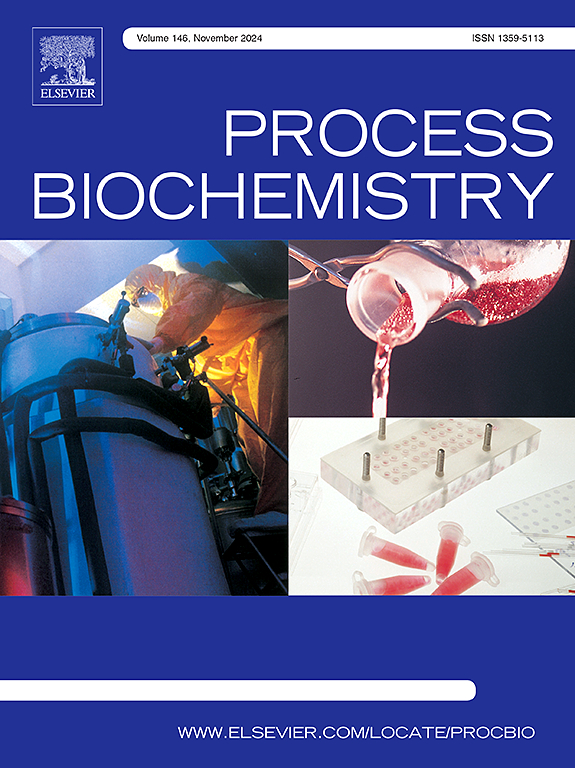微量元素的含量直接影响米瘟霉brm59907生产粟蓝素
IF 4
3区 生物学
Q2 BIOCHEMISTRY & MOLECULAR BIOLOGY
引用次数: 0
摘要
真菌次生代谢物是一种具有多种生物活性的可再生化合物,在药物、着色剂和农用化学品方面具有很大的潜力。它们的生物技术生产瓶颈,如低产量和可变产量,可以通过生物过程工程技术和实验设计来克服。使用这些策略可以获得高产量和低成本的绿草蛋白,这是一种由米芽霉产生的广谱抗菌化合物。以水稻芽孢杆菌BRM 59907为原料,对其微量元素需求进行了优化。Plackett-Burman和Doehlert的设计表明,镁的补充抑制了cerulenin的生物合成,而铁源的添加则刺激了cerulenin的生物合成。因此,它是可能达成最优条件(20 g L−1甘油,5 g L−1葡萄糖,2.5 g L−1蛋白胨,0.025 g L−1氯化钠,0.029 g L−1 FeCl3, 28ºC和150 rpm)减少74 %的浅蓝菌生产成本考虑只从原始条件培养基成分。生物反应器中的生物工艺放大在72 h内产生了1.39 mg L−1 h−1的蓝绿蛋白。这项工作提出了第一个有效利用甘油作为次级代谢物生产的主要碳源的生物过程。补充镁能促进细胞生长,但抑制蓝褐素的产生,而添加铁能提高蓝褐素的浓度。本文章由计算机程序翻译,如有差异,请以英文原文为准。
Micronutrients content directly impact cerulenin production by Sarocladium oryzae BRM 59907
Fungal secondary metabolites, renewable compounds with diverse bioactivities, offer potential for medicines, colorants, and agrochemicals. Their biotechnological production bottlenecks, such as low production and variable yield, can be overcome through bioprocess engineering techniques and experimental designs. Cerulenin, a broad-spectrum antimicrobial compound produced by Sarocladium oryzae, can be obtained with higher yields and lower costs using these strategies. In this work, cerulenin production by Sarocladium oryzae BRM 59907 was optimized considering its micronutrient requirements. Plackett-Burman and Doehlert designs showed that magnesium supplementation inhibits cerulenin biosynthesis, while the addition of iron source stimulates it. Thus, it was possible to reach an optimal condition (20 g L−1 glycerol, 5 g L−1 glucose, 2.5 g L−1 peptone, 0.025 g L−1 NaCl, 0.029 g L−1 FeCl3, 28 ºC and 150 rpm) with a reduction of 74 % in the cerulenin production cost considering only culture medium components from the original condition. Bioprocess scale-up in a bioreactor resulted in a cerulenin productivity of 1.39 mg L−1 h−1 in 72 h. This work presents the first bioprocess that efficiently utilizes glycerol as the primary carbon source for the secondary metabolite production. Magnesium supplementation increased cell growth but inhibited cerulenin production, while iron addition increased the concentration of cerulenin.
求助全文
通过发布文献求助,成功后即可免费获取论文全文。
去求助
来源期刊

Process Biochemistry
生物-工程:化工
CiteScore
8.30
自引率
4.50%
发文量
374
审稿时长
53 days
期刊介绍:
Process Biochemistry is an application-orientated research journal devoted to reporting advances with originality and novelty, in the science and technology of the processes involving bioactive molecules and living organisms. These processes concern the production of useful metabolites or materials, or the removal of toxic compounds using tools and methods of current biology and engineering. Its main areas of interest include novel bioprocesses and enabling technologies (such as nanobiotechnology, tissue engineering, directed evolution, metabolic engineering, systems biology, and synthetic biology) applicable in food (nutraceutical), healthcare (medical, pharmaceutical, cosmetic), energy (biofuels), environmental, and biorefinery industries and their underlying biological and engineering principles.
 求助内容:
求助内容: 应助结果提醒方式:
应助结果提醒方式:


